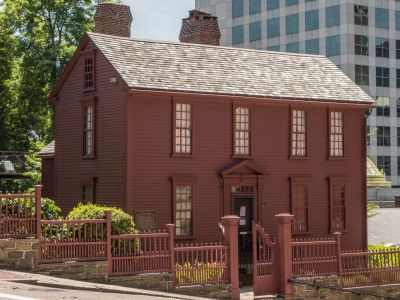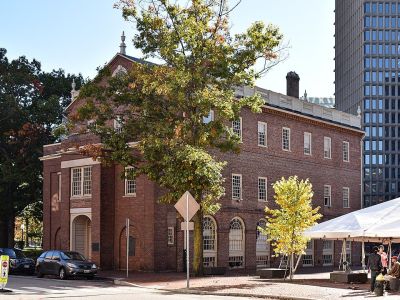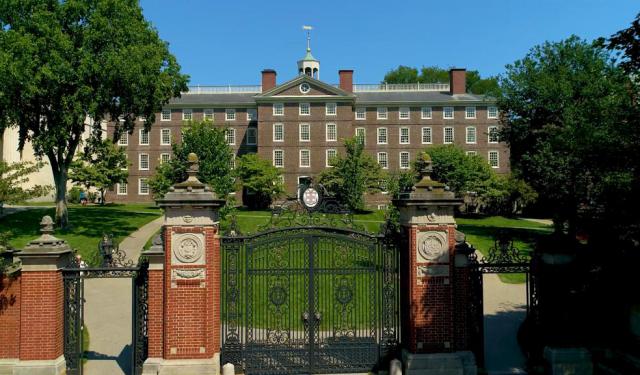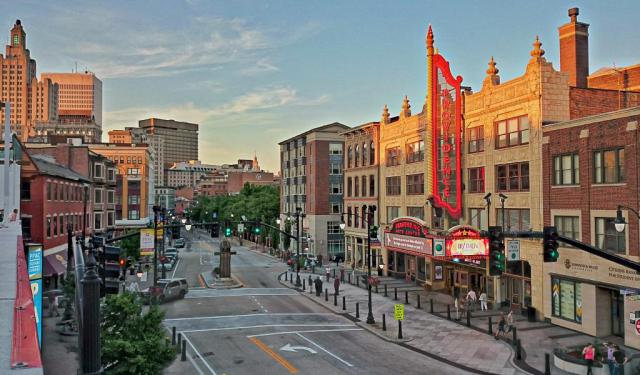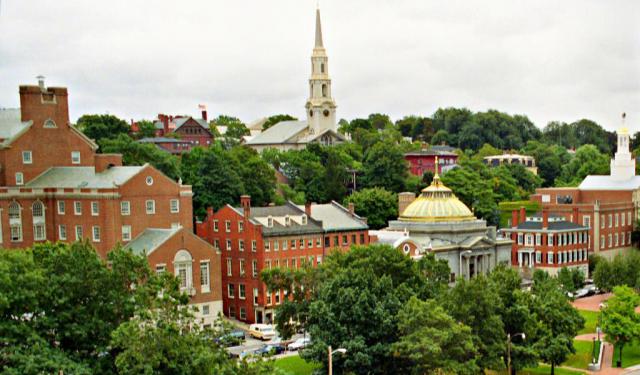
Providence Historical Buildings Tour (Self Guided), Providence
A beautiful city on the banks of the Providence River, Providence, Rhode Island, is nearly as old as the United States themselves – founded in 1636. As such, the city has many interesting historical and architectural landmarks worth checking out that tell the story of its past.
Among these, the Providence County Courthouse stands as a symbol of justice and governance. The Old Stone Bank, with its sturdy stone façade, lives up to its name and serves as a reminder of the city's financial history. The Governor Stephen Hopkins House offers a glimpse into the life of one of Rhode Island's prominent figures, while the Providence Athenaeum is a testament to the city's intellectual heritage.
The Brick School House once played a pivotal role in Providence's educational history, currently housing the headquarters for the Providence Preservation Society. The Old State House, with its elegant architecture, is a landmark of governmental authority. For those seeking a unique stay, the Old Court Bed & Breakfast offers a charming retreat within historical walls. The Sullivan Dorr House and the Sarah Helen Whitman House provide insights into the lives of notable Providence residents.
Religious heritage is also evident in the Cathedral of Saint John, a majestic structure that has been a focal point of spiritual life for generations. Fleur-de-Lis Studios showcases the city's artistic flair, while the Market House – listed on the National Register of Historic Places – remains a hub of activity as a part of the Rhode Island School of Design since 1948.
Collectively, these historical buildings represent a window into Providence's past, allowing visitors to connect with the city's profound heritage. A visit there promises a culturally enriching experience – a chance to learn about the stories embedded in these walls. So why not take this self-guided stroll and discover the charm of Providence's historical buildings for yourself?
Among these, the Providence County Courthouse stands as a symbol of justice and governance. The Old Stone Bank, with its sturdy stone façade, lives up to its name and serves as a reminder of the city's financial history. The Governor Stephen Hopkins House offers a glimpse into the life of one of Rhode Island's prominent figures, while the Providence Athenaeum is a testament to the city's intellectual heritage.
The Brick School House once played a pivotal role in Providence's educational history, currently housing the headquarters for the Providence Preservation Society. The Old State House, with its elegant architecture, is a landmark of governmental authority. For those seeking a unique stay, the Old Court Bed & Breakfast offers a charming retreat within historical walls. The Sullivan Dorr House and the Sarah Helen Whitman House provide insights into the lives of notable Providence residents.
Religious heritage is also evident in the Cathedral of Saint John, a majestic structure that has been a focal point of spiritual life for generations. Fleur-de-Lis Studios showcases the city's artistic flair, while the Market House – listed on the National Register of Historic Places – remains a hub of activity as a part of the Rhode Island School of Design since 1948.
Collectively, these historical buildings represent a window into Providence's past, allowing visitors to connect with the city's profound heritage. A visit there promises a culturally enriching experience – a chance to learn about the stories embedded in these walls. So why not take this self-guided stroll and discover the charm of Providence's historical buildings for yourself?
How it works: Download the app "GPSmyCity: Walks in 1K+ Cities" from Apple App Store or Google Play Store to your mobile phone or tablet. The app turns your mobile device into a personal tour guide and its built-in GPS navigation functions guide you from one tour stop to next. The app works offline, so no data plan is needed when traveling abroad.
Providence Historical Buildings Tour Map
Guide Name: Providence Historical Buildings Tour
Guide Location: USA » Providence (See other walking tours in Providence)
Guide Type: Self-guided Walking Tour (Sightseeing)
# of Attractions: 12
Tour Duration: 2 Hour(s)
Travel Distance: 2.0 Km or 1.2 Miles
Author: alice
Sight(s) Featured in This Guide:
Guide Location: USA » Providence (See other walking tours in Providence)
Guide Type: Self-guided Walking Tour (Sightseeing)
# of Attractions: 12
Tour Duration: 2 Hour(s)
Travel Distance: 2.0 Km or 1.2 Miles
Author: alice
Sight(s) Featured in This Guide:
- Providence County Courthouse
- Old Stone Bank
- Governor Stephen Hopkins House
- Providence Athenaeum
- Brick School House
- Old State House
- Old Court Bed & Breakfast
- Sullivan Dorr House
- Sarah Helen Whitman House
- Cathedral of St. John
- Fleur-de-Lis Studios
- Market House
1) Providence County Courthouse
The Providence County Courthouse (also known as the Frank Licht Judicial Complex) is a Georgian Revival building in the College Hill neighborhood of Providence. The building contains the state's court of last resort, the Rhode Island Supreme Court, and the local trial court, the Providence County Superior Court.
The lot currently occupied by the courthouse has been used for governmental and judicial purposes since the since the 18th century. In 1794, the city purchased a building at the southern corner of College and Benefit Streets originally built in 1723 by the First Congregational Society for use as a meeting house. Known as the "town house," this building hosted public meetings and was occasionally used as a courthouse.
In March of 1875, the property was condemned and a city commission began work to construct a new public building at the site. The resulting courthouse, was designed by Stone & Carpenter in the High Victorian Gothic style. Work on the structure began in July of 1875 and was completed in December of 1877.
The current building was constructed in 1923. The building is constructed from red brick with granite and limestone trim. The exterior of the building is designed in the Georgian Revival style while the interior follows an iteration of the Federal style.
The Providence County Courthouse is lauded for its contextualism, which defers in its design to the buildings surrounding. Architectural historian McKenzie Woodward commends the fragmentation of the building's large mass into "visually digestible units".
The lot currently occupied by the courthouse has been used for governmental and judicial purposes since the since the 18th century. In 1794, the city purchased a building at the southern corner of College and Benefit Streets originally built in 1723 by the First Congregational Society for use as a meeting house. Known as the "town house," this building hosted public meetings and was occasionally used as a courthouse.
In March of 1875, the property was condemned and a city commission began work to construct a new public building at the site. The resulting courthouse, was designed by Stone & Carpenter in the High Victorian Gothic style. Work on the structure began in July of 1875 and was completed in December of 1877.
The current building was constructed in 1923. The building is constructed from red brick with granite and limestone trim. The exterior of the building is designed in the Georgian Revival style while the interior follows an iteration of the Federal style.
The Providence County Courthouse is lauded for its contextualism, which defers in its design to the buildings surrounding. Architectural historian McKenzie Woodward commends the fragmentation of the building's large mass into "visually digestible units".
Sight description based on Wikipedia.
2) Old Stone Bank
Old Stone Bank was a popular Rhode Island banking institution that was founded in Providence in 1819 as a mutual savings bank that was called Providence Institution for Savings.
The landmark Old Stone Bank Building, from which the bank derived its popular nickname and which housed the bank's flagship branch, is located on South Main Street in Providence. The granite edifice with a distinctive gold leaf, spired dome was designed by C.J. and R.J. Hall in 1854 and is a prime example of the style of bank architecture, prevalent from the mid-19th to the mid-20th Century, which communicated stability, strength and permanence.
The Old Stone Bank is one of the few buildings in Providence that has remained virtually unchanged from its original state.
The landmark Old Stone Bank Building, from which the bank derived its popular nickname and which housed the bank's flagship branch, is located on South Main Street in Providence. The granite edifice with a distinctive gold leaf, spired dome was designed by C.J. and R.J. Hall in 1854 and is a prime example of the style of bank architecture, prevalent from the mid-19th to the mid-20th Century, which communicated stability, strength and permanence.
The Old Stone Bank is one of the few buildings in Providence that has remained virtually unchanged from its original state.
Sight description based on Wikipedia.
3) Governor Stephen Hopkins House (must see)
The Governor Stephen Hopkins House is a historic house museum. It was home to Rhode Island Governor Stephen Hopkins, who was also a signatory of the Declaration of Independence. The bulk of the house was built in 1743.
The original house was built in 1707. It was purchased by Hopkins who had the home significantly altered and enlarged. Visitors will see a central hallway, parlor, study, kitchen and five bedrooms. A room on the building's second floor is thought to have been the slave quarters.
Hopkins lived in the home until his death in 1785. However, at that time, the house was on South Maine and Hopkins Streets. It was moved in 1928 to its present location. The home is maintained and operated by the National Society of the Colonial Dames of America. It was placed on the National Register of Historic Places in 1970 and was declared a National Historic Landmark in 1978.
The house is open on Wednesdays from 11 AM to 2 PM throughout the year. From April to November, it is also open on Saturdays from 10 AM to 4 PM. The home is open at other times by appointment only.
The original house was built in 1707. It was purchased by Hopkins who had the home significantly altered and enlarged. Visitors will see a central hallway, parlor, study, kitchen and five bedrooms. A room on the building's second floor is thought to have been the slave quarters.
Hopkins lived in the home until his death in 1785. However, at that time, the house was on South Maine and Hopkins Streets. It was moved in 1928 to its present location. The home is maintained and operated by the National Society of the Colonial Dames of America. It was placed on the National Register of Historic Places in 1970 and was declared a National Historic Landmark in 1978.
The house is open on Wednesdays from 11 AM to 2 PM throughout the year. From April to November, it is also open on Saturdays from 10 AM to 4 PM. The home is open at other times by appointment only.
4) Providence Athenaeum
The Providence Athenaeum, founded in 1753, is the fourth oldest subscription library in the United States. In 1753 a group of private citizens started The Providence Library Company to gain access to a collection of books that they could not afford individually. Members paid a small subscription fee to the library to purchase books which all members could share. Stephen Hopkins, signatory of the Declaration of Independence, was a leading member of the early organization. Many of the early books had to be purchased from England.
In 1758, a fire destroyed the first collection of books, which were then housed at the Providence court house. Shortly after Brown University moved to Providence in 1770, the library offered students the use of its books. In 1836 the Providence Library Company merged with the Providence Atheneum (founded in 1831), and the merged organization became known as the Providence Athenaeum. In 1838 a new Greek Revival building was completed on Benefit Street by the Philadelphia architect, William Strickland.
In 1758, a fire destroyed the first collection of books, which were then housed at the Providence court house. Shortly after Brown University moved to Providence in 1770, the library offered students the use of its books. In 1836 the Providence Library Company merged with the Providence Atheneum (founded in 1831), and the merged organization became known as the Providence Athenaeum. In 1838 a new Greek Revival building was completed on Benefit Street by the Philadelphia architect, William Strickland.
Sight description based on Wikipedia.
5) Brick School House
The Brick Schoolhouse (Meeting Street School or Providence Preservation Society) is an historic colonial meeting house and school at 24 Meeting Street. The school was built in 1768 to serve as a school and meeting place for town meetings. When Brown University moved from Warren to Providence in 1770, the building temporarily housed the school and classes were again held at the school after University Hall housed French troops during the American Revolution.
In the 1790s a group of Rhode Islanders led by John Howland successfully advocated for free public schools, and started one of the first free public schools in 1800 within the Brick Schoolhouse at 24 Meeting Street. Over the next two centuries the building housed various schools including "a school for black children, a cooking school, and a fresh air school for tubercular children, the first such program in America.
From 1946 to 1957, the Meeting Street School met in the Brick Schoolhouse" educating children with cerebral palsy. The building was added to the National Register of Historic Places in 1972. The building currently serves as the headquarters for the Providence Preservation Society, a group founded in 1958, which hosts various educational and community events at the property.
In the 1790s a group of Rhode Islanders led by John Howland successfully advocated for free public schools, and started one of the first free public schools in 1800 within the Brick Schoolhouse at 24 Meeting Street. Over the next two centuries the building housed various schools including "a school for black children, a cooking school, and a fresh air school for tubercular children, the first such program in America.
From 1946 to 1957, the Meeting Street School met in the Brick Schoolhouse" educating children with cerebral palsy. The building was added to the National Register of Historic Places in 1972. The building currently serves as the headquarters for the Providence Preservation Society, a group founded in 1958, which hosts various educational and community events at the property.
Sight description based on Wikipedia.
6) Old State House
The Old State House on College Hill, known also as Providence Sixth District Court House, is located on 150 Benefit Street. It is a brick Georgian-style building completed largely in 1762. It was used as the meeting place for the colonial and state legislatures for 149 years.
From colonial times to the mid-19th century, the Rhode Island General Assembly rotated meetings between the state's five county court houses, and five former Rhode Island state houses survive nowadays. In 1760 The General Assembly built the Old State House to replace an earlier wooden courthouse built 1730 on Meeting Street. It was largely finished by 1762 with some details being completed by 1771. Many of the Georgian architecture details were borrowed from the larger and more ornate Newport Colony House.
Before 19th century alterations to the Providence State House, the two buildings resembled one another greatly. In the 19th century the large center-front tower was added. After 1853 the state legislature ceased meeting at Kent, Washington and Bristol county courthouses, but continued to alternate its sessions between here and the Newport State House in Newport into the early 20th century.
At the Old State House on May 4, 1776, the General Assembly declared its independence renouncing its allegiance to the British crown, and the date is now celebrated as Rhode Island Independence Day. Debates about slavery occurred in the building in the late 18th century. George Washington visited the building in 1781 and 1790.
From colonial times to the mid-19th century, the Rhode Island General Assembly rotated meetings between the state's five county court houses, and five former Rhode Island state houses survive nowadays. In 1760 The General Assembly built the Old State House to replace an earlier wooden courthouse built 1730 on Meeting Street. It was largely finished by 1762 with some details being completed by 1771. Many of the Georgian architecture details were borrowed from the larger and more ornate Newport Colony House.
Before 19th century alterations to the Providence State House, the two buildings resembled one another greatly. In the 19th century the large center-front tower was added. After 1853 the state legislature ceased meeting at Kent, Washington and Bristol county courthouses, but continued to alternate its sessions between here and the Newport State House in Newport into the early 20th century.
At the Old State House on May 4, 1776, the General Assembly declared its independence renouncing its allegiance to the British crown, and the date is now celebrated as Rhode Island Independence Day. Debates about slavery occurred in the building in the late 18th century. George Washington visited the building in 1781 and 1790.
Sight description based on Wikipedia.
7) Old Court Bed & Breakfast
The Old Court Bed & Breakfast is a historic inn in the College Hill neighborhood. The home was built in 1863 as a rectory by architect Alpheus Morse. It was crafted in the Victorian-Italianate Architectural Style.
Inside the building, visitors will see that much of the Victorian style has been preserved. The bed and breakfast retains its original mantles, plaster crown moulding and restored light fixtures. The inn uses period-friendly wallpaper, wood floors and 19th century-style artwork while also offering modern conveniences like air conditioning and wifi.
Likewise, each of the rooms has its own, unique styles from the 19th century. There are 10 rooms at the Old Court Bed & Breakfast. They all have private bathrooms. Some offer sitting areas and even a fireplace.
The Old Court Bed & Breakfast only a three minute walk from downtown and is just steps away from the Brown University campus. It is located next to the Old State House museum.
Inside the building, visitors will see that much of the Victorian style has been preserved. The bed and breakfast retains its original mantles, plaster crown moulding and restored light fixtures. The inn uses period-friendly wallpaper, wood floors and 19th century-style artwork while also offering modern conveniences like air conditioning and wifi.
Likewise, each of the rooms has its own, unique styles from the 19th century. There are 10 rooms at the Old Court Bed & Breakfast. They all have private bathrooms. Some offer sitting areas and even a fireplace.
The Old Court Bed & Breakfast only a three minute walk from downtown and is just steps away from the Brown University campus. It is located next to the Old State House museum.
8) Sullivan Dorr House
The Sullivan Dorr House was built in 1809 by architect John Holden Greene on the original burial site of Roger Williams, the founder of Providence. The home, located at 109 Benefit Street, is a combination of architectural styles known as Strawberry Hill Gothic. This style is a combination of Georgian, Gothic and Palladian techniques to create an entirely unique-looking home.
The home was built for shipping magnate Sullivan Dorr and his wife, Lydia Allen. The main section of the home is three stories with two-story wings on each side. Those passing by will also notice that the covered entrance is surrounded by slender, Gothic columns. A servants' quarters and barn were built at the same time as the home.
The Sullivan Dorr House was given to the Providence Preservation Society by Dorr's great granddaughter, Margarethe Lyman Dwight, in 1956. It was the first home preserved by the society. Today, the house is more than 6,000 square feet with nine bedrooms and six bathrooms. The former carriage house has been converted into a garage.
The home was built for shipping magnate Sullivan Dorr and his wife, Lydia Allen. The main section of the home is three stories with two-story wings on each side. Those passing by will also notice that the covered entrance is surrounded by slender, Gothic columns. A servants' quarters and barn were built at the same time as the home.
The Sullivan Dorr House was given to the Providence Preservation Society by Dorr's great granddaughter, Margarethe Lyman Dwight, in 1956. It was the first home preserved by the society. Today, the house is more than 6,000 square feet with nine bedrooms and six bathrooms. The former carriage house has been converted into a garage.
9) Sarah Helen Whitman House
The Sarah Helen Whitman House is a home that belonged to former American poet, Sarah Helen Whitman. The 18th-century home was purchased by Whitman's mother when her daughters were young. Whitman returned to the house after her husband died and continued to live there for many years.
Whitman is remembered as much for her relationship with Edgar Allan Poe as she is for her poetry. It was at this home that Whitman met Poe. She inspired Poe's poem "To Helen," which was reportedly written at this residence.
The two-story home is noted for its Colonial architecture. Building on the home began in 1783 and was completed in 1793. Additional work was done in 1875, well after Whitman no longer lived at the residence.
The house is located at 88 Benefit Street. Its hilltop locations offers a perfect view of St. John's Cathedral and its cemetery. It is sometimes also credited as the Benjamin & John Reynolds House. The home is privately owned.
Whitman is remembered as much for her relationship with Edgar Allan Poe as she is for her poetry. It was at this home that Whitman met Poe. She inspired Poe's poem "To Helen," which was reportedly written at this residence.
The two-story home is noted for its Colonial architecture. Building on the home began in 1783 and was completed in 1793. Additional work was done in 1875, well after Whitman no longer lived at the residence.
The house is located at 88 Benefit Street. Its hilltop locations offers a perfect view of St. John's Cathedral and its cemetery. It is sometimes also credited as the Benjamin & John Reynolds House. The home is privately owned.
10) Cathedral of St. John
The Cathedral of St. John, located at 271 North Main Street, is the seat of the Episcopal Diocese of Rhode Island of The Episcopal Church. The parish was originally organized in 1722 as King's Church, a wooden structure that was renamed St John's Church in 1794. That building served Providence until 1810 when work began on what would become the Cathedral of St. John. The Episcopal Diocese of Rhode Island was formed in 1790, but it was not until 1929 that St John's Church was designated the Episcopal seat and was renamed the Cathedral of St. John.
The cornerstone for St. John's Church was laid in 1810 and the church was dedicated in 1811. The building was designed by Federal-era architect John Holden Greene, who designed many buildings in Providence. A Cathedral corporation was formed in 1909 and in 1929, the church was designated the Episcopal seat. The building was renovated in 1855, 1866, 1906, and 1967, and still retains its architectural integrity, but is in a state of deterioration and was listed on the Providence Preservation Society 10 Most Endangered Properties List in 2007, 2008 and 2010.
The cornerstone for St. John's Church was laid in 1810 and the church was dedicated in 1811. The building was designed by Federal-era architect John Holden Greene, who designed many buildings in Providence. A Cathedral corporation was formed in 1909 and in 1929, the church was designated the Episcopal seat. The building was renovated in 1855, 1866, 1906, and 1967, and still retains its architectural integrity, but is in a state of deterioration and was listed on the Providence Preservation Society 10 Most Endangered Properties List in 2007, 2008 and 2010.
Sight description based on Wikipedia.
11) Fleur-de-Lis Studios
Fleur-de-lys Studios is a Tudor Revival style home built in 1885. It was designed by architect Edmund Russell Willson and artist Sydney Richmond Burleigh. It is known to be instrumental in the creation of the Arts and Crafts movement.
The house is timber and stucco with casement windows of varying sizes. The exterior of the home is decorated with panels that represent sculpture, painting and architecture. It was used by Burleigh as an art studio and as the location of the Providence Art Club.
The home was gifted to the Providence Art Club in 1939 by Burleigh's widow. The requirement for the gift was that it continue to be used as an art studio. While the Providence Art Club has expanded, the Fleur-de-Lys house is still an important part of the club. The house was designated as a National Historic Landmark in 1992.
The house is timber and stucco with casement windows of varying sizes. The exterior of the home is decorated with panels that represent sculpture, painting and architecture. It was used by Burleigh as an art studio and as the location of the Providence Art Club.
The home was gifted to the Providence Art Club in 1939 by Burleigh's widow. The requirement for the gift was that it continue to be used as an art studio. While the Providence Art Club has expanded, the Fleur-de-Lys house is still an important part of the club. The house was designated as a National Historic Landmark in 1992.
12) Market House
Market House is a historic house in the College Hill neighborhood. It was built in 1775 from a design by architects Joseph Brown and Stephen Hopkins. The building was used as both a market and meeting place. It was the home of the Providence City Council before City Hall was built.
The original building had only two stories. Twenty years after its completion, a third floor was added for the Masonic Lodge. The two story addition, which includes an entrance to the masonic hall, was added in 1833 by architect James C. Bucklin. The clock on its west side was added during the 20th century.
The building was used for a number of purposes over the years. It served as a barracks for French soldiers during the American Revolution. It was home to the Chamber of Commerce, several manufacturing companies and the Rhode Island Electric Light Company.
In 1948, the building was given to the Rhode Island School of Design. It was remodeled to have classrooms and studios on the inside, but the deed stated that the exterior of the building must remain true to its original design. It was added to the National Register of Historic Places in 1972.
The original building had only two stories. Twenty years after its completion, a third floor was added for the Masonic Lodge. The two story addition, which includes an entrance to the masonic hall, was added in 1833 by architect James C. Bucklin. The clock on its west side was added during the 20th century.
The building was used for a number of purposes over the years. It served as a barracks for French soldiers during the American Revolution. It was home to the Chamber of Commerce, several manufacturing companies and the Rhode Island Electric Light Company.
In 1948, the building was given to the Rhode Island School of Design. It was remodeled to have classrooms and studios on the inside, but the deed stated that the exterior of the building must remain true to its original design. It was added to the National Register of Historic Places in 1972.
Walking Tours in Providence, Rhode Island
Create Your Own Walk in Providence
Creating your own self-guided walk in Providence is easy and fun. Choose the city attractions that you want to see and a walk route map will be created just for you. You can even set your hotel as the start point of the walk.
Brown University Walking Tour
Chief among the iconic landmarks contributing to the cultural atmosphere of Providence, Rhode Island, is Brown University, a prestigious Ivy League institution known for its liberal arts education and vibrant campus life. Founded in 1764, this is the seventh-oldest university in the United States, chartered before the American Revolution.
Brown's historic campus offers a classic New... view more
Tour Duration: 2 Hour(s)
Travel Distance: 2.3 Km or 1.4 Miles
Brown's historic campus offers a classic New... view more
Tour Duration: 2 Hour(s)
Travel Distance: 2.3 Km or 1.4 Miles
Providence Introduction Walking Tour
Providence, the capital of the US state of Rhode Island, is one of the oldest cities in New England. Founded in 1636 by the Puritan theologian Roger Williams, it was one of the original Thirteen Colonies that formed the United States. The settlement was named after "God's merciful Providence" which Williams believed was responsible for revealing such a haven for him and his... view more
Tour Duration: 2 Hour(s)
Travel Distance: 3.9 Km or 2.4 Miles
Tour Duration: 2 Hour(s)
Travel Distance: 3.9 Km or 2.4 Miles
The Most Popular Cities
/ view all


